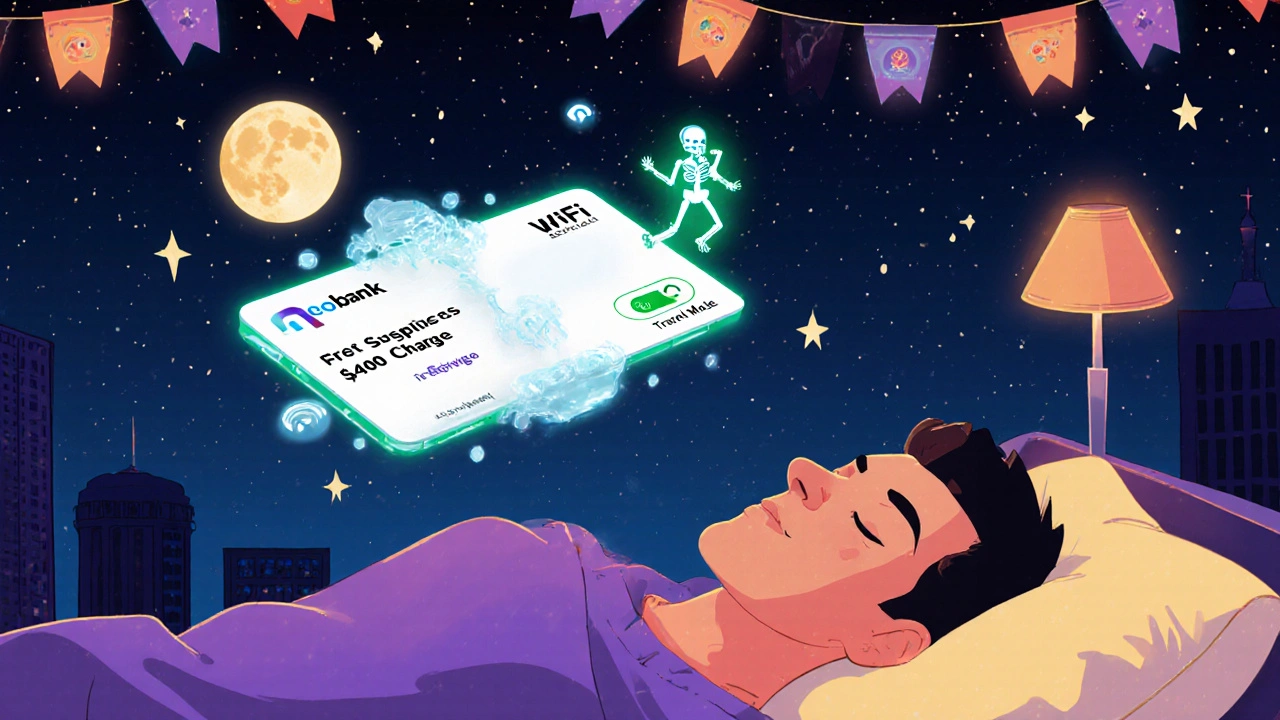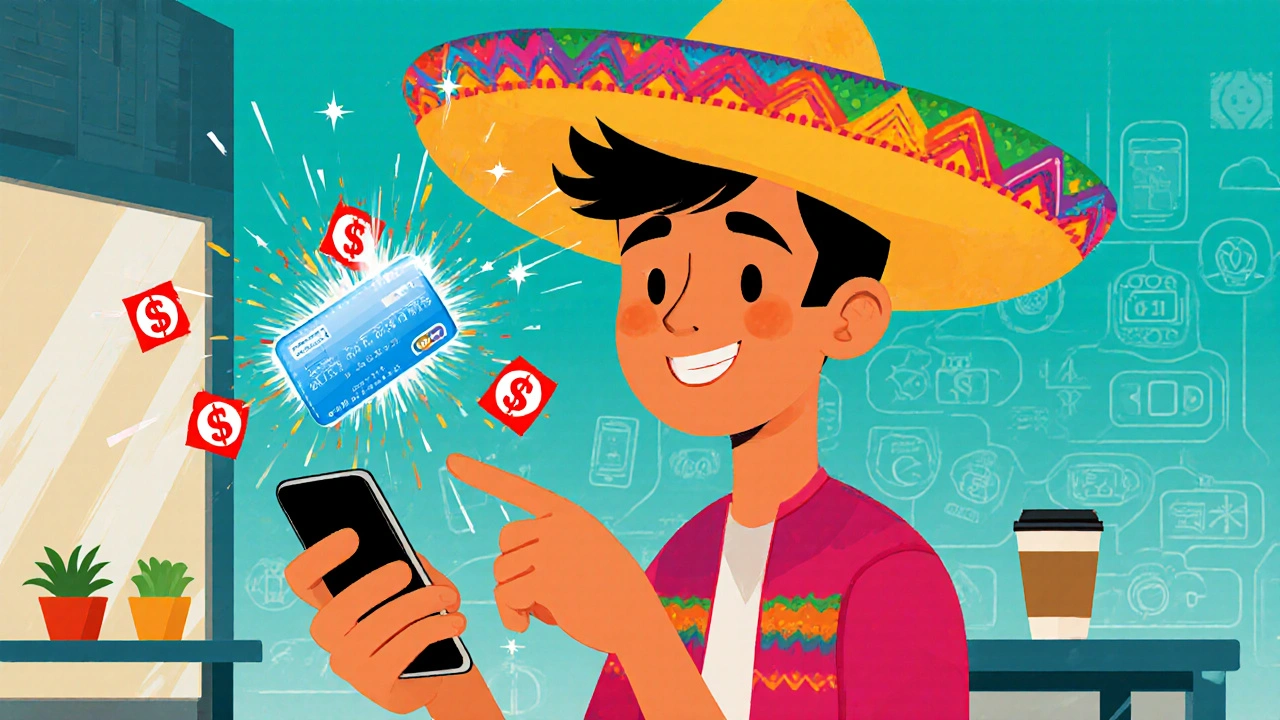Neobank Card Control Simulator
Your Virtual Neobank Card
Test real-time card controls just like at Revolut or Chime
Freeze Card
All transactions will be blocked immediately
Spending Limits
Alert Settings
Adjust settings to reduce false positives
Transaction Simulator
Test how your settings work in real scenarios
Your Control Status
Imagine this: you’re standing in line at a coffee shop, and your phone buzzes. A $499 charge just popped up from a store you’ve never heard of. Your heart drops. But instead of panicking, you open your neobank app, tap freeze card, and it’s done-within a second. No calls. No waiting. No more $1,200 in fraudulent charges that could’ve followed. This isn’t science fiction. It’s what neobanks made possible, and it’s now the new standard for how people manage money.
Why Card Controls Matter More Than Ever
Traditional banks still make you call customer service to freeze a lost card. Sometimes it takes hours. Neobanks changed that. With real-time controls built into your phone, you’re no longer at the mercy of outdated systems. You’re in charge. And it’s not just about stopping fraud. These tools let you control how, when, and where your money moves-something most people never knew they needed until they had it.By 2025, 92% of neobanks offer full card control features. That’s up from just 35% at traditional banks. Why? Because users demanded it. And the data backs it up: neobank customers who use card controls see a 63% drop in fraudulent losses, according to the Federal Reserve. That’s not a small win. It’s life-changing.
How Freezing Your Card Actually Works
Freezing a card isn’t just turning it off. It’s a live signal sent through Visa or Mastercard’s secure networks-right to the card processor. The system recognizes your device, verifies your identity (usually via Face ID or fingerprint), and instantly blocks all new transactions. No exceptions. Not even ATM withdrawals or online purchases.The speed? Around 0.8 to 1.2 seconds. Compare that to traditional banks, where it can take 4 to 6 hours. That gap isn’t just annoying-it’s dangerous. In 2024, a J.D. Power study found neobanks froze cards 6 times faster than traditional ones. When fraud happens, seconds count.
Most apps let you freeze one card or all cards at once. Some, like Current, even let you pause spending by category-say, stop all restaurant charges but keep gas and groceries active. That’s useful if you’re trying to stick to a budget without cutting off essentials.
But there’s a catch. If you freeze your card and then try to pay for something legitimate-like a monthly subscription-you’ll get declined. That’s why 41% of users, according to Visa’s Chief Security Officer, accidentally disrupt recurring payments. Always check your active subscriptions before freezing.
Spending Limits: More Than Just a Budget Tool
Spending limits on neobank cards aren’t just about capping your monthly coffee run. They’re smart, customizable, and tied directly to your behavior.Most platforms let you set limits by:
- Merchant category (like dining, entertainment, or gas)
- Location (block international use or restrict spending to your home country)
- Transaction type (online vs. in-store vs. ATM)
- Time period (daily, weekly, or monthly caps)
For example, you could set a $50 daily limit on food delivery apps but allow unlimited spending at grocery stores. Or block all online purchases unless you’re on Wi-Fi. Revolut takes this further with 18 different control parameters-far more than any traditional bank offers.
Some apps, like Varo, even let you set limits per merchant. So you could allow $200 at Amazon but only $50 at a random online retailer. This level of control is unheard of in legacy banking.
And here’s the kicker: 78% of top neobanks now link these limits to spending analytics. If you’ve been overspending on streaming services for the last 90 days, Chime might suggest lowering your limit to $30/week. It’s not just control-it’s coaching.
Alerts That Actually Help, Not Annoy
Transaction alerts are everywhere. But most banks send you every single purchase-$3 for coffee, $12 for a snack, $8 for a bus ride. It’s noise. Neobanks made alerts useful.Instead of flooding your phone, smart neobanks let you choose what matters:
- Only alerts for transactions over $25
- Only alerts for international or online purchases
- Only alerts for unusual locations (like a $400 charge in Tokyo when you’re in Denver)
Some apps, like Current, even use AI to flag suspicious activity before you even notice. If your card gets used at a pawn shop at 3 a.m., you’ll get a warning before the transaction completes.
But it’s not perfect. About 31% of users report false alerts triggering automatic freezes. That’s often because the system misreads a merchant category-like tagging a pharmacy as a “high-risk” location. If this happens often, you can adjust your alert settings or whitelist trusted merchants.
And if you’re traveling? You’ll want to turn off location-based alerts to avoid false alarms. Most apps let you set a “travel mode” that disables these triggers while keeping fraud protection active.

What Sets Neobanks Apart from Traditional Banks
Here’s the truth: traditional banks are playing catch-up. Chase and Bank of America have basic freezing now. But they still don’t offer merchant-specific limits, geographic controls, or dynamic CVV changes-all features common in neobanks by 2025.And it’s not just about features. It’s about speed and cost. Neobanks offer all these tools for free. Traditional banks charge $2-$5 a month for “premium” controls. That’s like paying extra to unlock basic safety features on your car.
Neobanks also update faster. Revolut rolled out location-based freezing in September 2025. Chime added AI spending suggestions in August. These updates happen every few months. Traditional banks? They update every 2-3 years.
One area where traditional banks still win? Physical card replacements. If your card is stolen and you need a new one shipped overnight, banks with branches can hand you a replacement in person. Neobanks have to mail it-which can take 5-7 days. But if you’re worried about fraud, freezing the card instantly is far more valuable than waiting for a new plastic card.
Real People, Real Stories
On Reddit, a user named u/DigitalBanker88 shared how they froze their Revolut card in under 90 seconds after spotting a $499 charge at a fake online store. Within minutes, two more attempts were blocked. They saved over $1,600 in potential fraud.Another user on Trustpilot said Chime’s card controls gave them peace of mind after their wallet was stolen. “I didn’t have to cancel my card. I just paused it. My Uber and grocery payments kept working. My credit card was fine. No stress,” they wrote.
But not all stories are smooth. Some users report issues unfreezing cards while abroad because the app requires a biometric check they can’t do on a foreign network. Others say merchant categories get mislabeled-like a hardware store flagged as “home improvement” instead of “retail,” triggering a spending limit they didn’t set.
These aren’t dealbreakers. They’re quirks. And most are fixable through app settings or support chat.
What’s Coming Next
The next wave of card controls is even smarter. By late 2025, Varo is testing “Temporary Merchant Whitelisting”-letting you bypass a spending limit for one purchase, like paying your electric bill, without turning off the rule entirely.Current is working on biometric transaction verification. Instead of typing a code, you’ll just tap your finger to approve a payment. No OTPs. No delays.
And in 2026, expect deeper integration with credit-building tools. If you use your card responsibly, your neobank might start reporting your payment patterns to credit bureaus. That’s huge for people with thin credit files.
Even more futuristic? Blockchain-based verification to stop SIM-swap attacks. And voice-controlled card management through Alexa or Google Home. By 2027, you might say, “Hey Google, freeze my card,” and it just works.

How to Get Started
If you’re new to neobanks, here’s how to use card controls right away:- Download your neobank app (Chime, Revolut, Current, Varo, etc.)
- Set up biometric login (Face ID or fingerprint)
- Find the “Card Controls” section-usually in the main menu
- Turn on instant freezing
- Set a daily spending limit for categories you overspend on
- Customize alerts: only notify you for transactions over $25 or outside your country
- Test it: make a small purchase, then freeze the card and try to spend again
It takes less than 5 minutes. And once you do, you’ll wonder how you ever lived without it.
Common Mistakes to Avoid
- Freezing without checking recurring payments-You’ll get declined on Netflix, Spotify, or your phone bill.
- Setting limits too low-If your grocery limit is $10/day, you’ll be stuck.
- Ignoring alerts-If you turn off all notifications, you lose the safety net.
- Forgetting to unfreeze-Some users freeze their card for vacation and forget to turn it back on.
Pro tip: Use the “pause spending” feature instead of full freezing if you’re just trying to cut back. It’s less disruptive.
Final Thoughts
Neobank card controls aren’t a gimmick. They’re the future of personal finance. They give you real power over your money-not just in theory, but in real time. And they’re free.Traditional banks might catch up eventually. But right now, if you want to protect your money, control your spending, and get alerts that actually help-you need a neobank. And you don’t need to be a tech expert. Just open the app. Tap. Done.

Laura W
October 31, 2025 AT 15:36OMG I just froze my card during a coffee run last week when I saw a $300 charge from some sketchy site in Lithuania. Took 0.9 seconds. My heart stopped, then I laughed because I literally didn’t even have to move from the line. Neobanks are the only reason I’m not sleeping with one eye open anymore. Also, the spending limits on dining? Life-changing. I used to blow $800/month on DoorDash. Now I’m at $150. My wallet and my waistline thank you.
And yes, I got flagged for ‘high-risk pharmacy’ once because I bought Tylenol in a weird neighborhood. Turned off location alerts, fixed it in 2 minutes. No biggie.
Graeme C
October 31, 2025 AT 20:50The assertion that traditional banks are ‘playing catch-up’ is not merely inaccurate-it is a gross underestimation of their institutional inertia. While neobanks leverage API-driven architecture to offer granular controls, legacy institutions are bound by PCI-DSS compliance, legacy core systems, and regulatory obligations that render real-time freezing non-trivial. The 63% reduction in fraud cited is statistically valid, but it ignores the fact that neobanks attract high-risk demographics: underbanked users with poor financial hygiene who are inherently more susceptible to fraud. The real metric is not fraud reduction-it’s cost per fraud incident, and here, traditional banks still dominate through insurance-backed liability frameworks.
Moreover, the claim that these features are ‘free’ is disingenuous. Neobanks monetize via interchange fees, premium subscriptions, and data brokerage. Your ‘free’ card control is paid for by the merchant who accepts your card. Don’t be fooled by the veneer of empowerment-it’s a business model dressed in UX glitter.
Dave McPherson
November 1, 2025 AT 13:24Oh wow. Another ‘neobanks are the future’ thinkpiece that reads like a Medium post written by a 22-year-old who just got their first Revolut card. Let’s be real-these ‘smart’ controls are just glorified parental controls for adults who can’t budget. You set a $50 limit on food delivery? Congrats, you’ve turned your bank into a toddler’s iPad.
And the ‘AI coaching’? That’s just a chatbot that says ‘you spent too much on Netflix’ after you’ve already maxed out your limit. I’ve used neobanks. I’ve seen the ‘unusual location’ alerts for my own damn apartment because the Wi-Fi IP was routed through Canada. It’s not innovation-it’s over-engineered chaos wrapped in a pretty UI.
And don’t even get me started on ‘biometric verification.’ I’m not tapping my finger every time I buy a burrito. I’m not a spy. I’m a human. And I’d rather have a $5 monthly fee for a real human on the line than a bot that freezes my card because I bought a USB cable from a ‘high-risk electronics vendor.’
Also, blockchain-based SIM-swap protection? That’s not coming in 2027. That’s coming when the neobank CEO finally stops selling his user data to advertisers. Until then, I’ll stick with my bank that lets me walk in and say ‘my card’s stolen’ and they hand me a new one while I wait for coffee. No app. No biometrics. Just a person who says ‘sorry about that.’
PS: If you’re using ‘card controls’ to stop yourself from spending, you don’t need a neobank. You need therapy.
RAHUL KUSHWAHA
November 2, 2025 AT 00:48Thanks for this 🙏 I just switched to Chime last month and the alerts saved me from a fake Amazon charge. I didn’t know how to freeze card before-now I feel safer. But yes, sometimes merchant categories get confused 😅 Like my local repair shop got tagged as ‘home improvement’ and blocked my $70 tool purchase. Fixed it in app after 5 mins. Small thing, but helpful!
Also, travel mode is a lifesaver. I used it in Thailand last week-no false alerts, no panic. Just peace. 💯